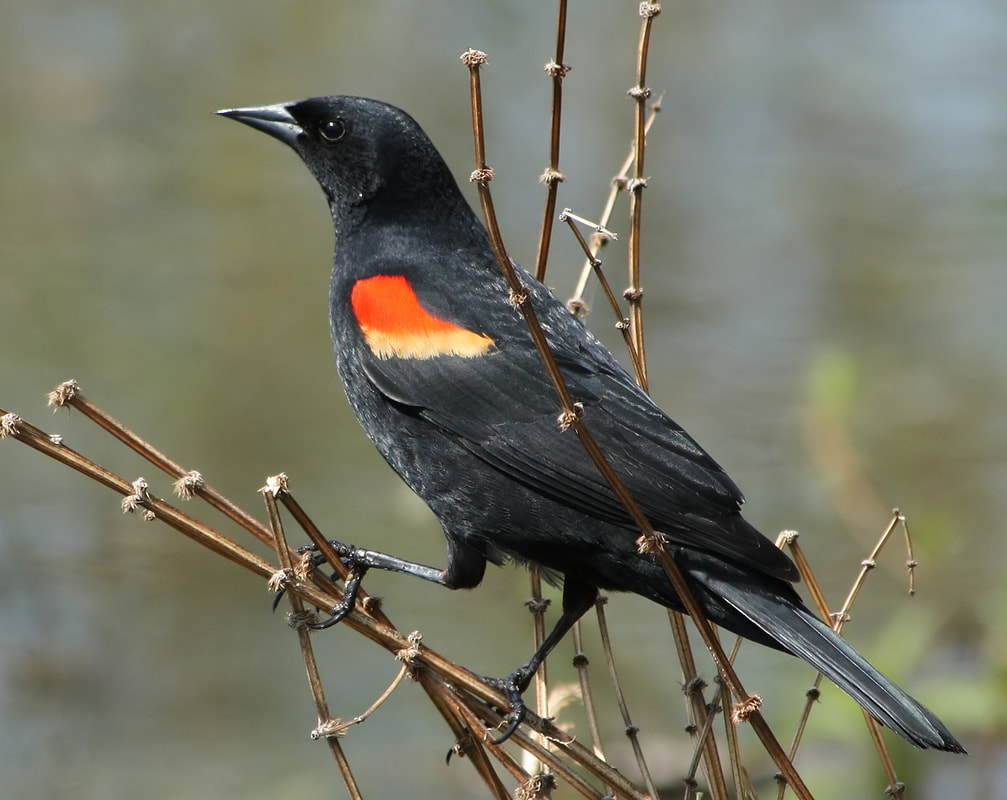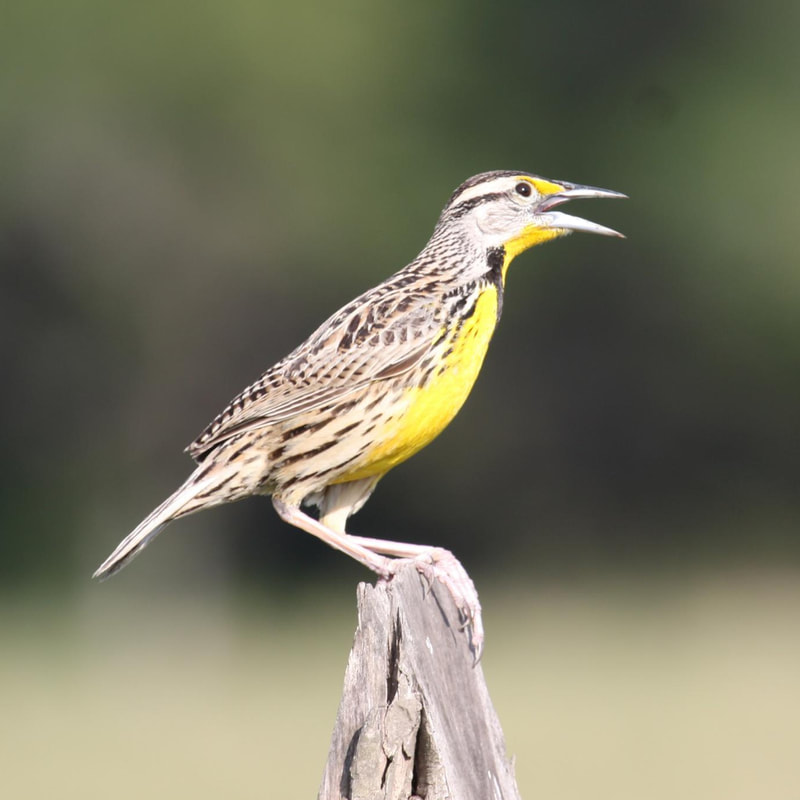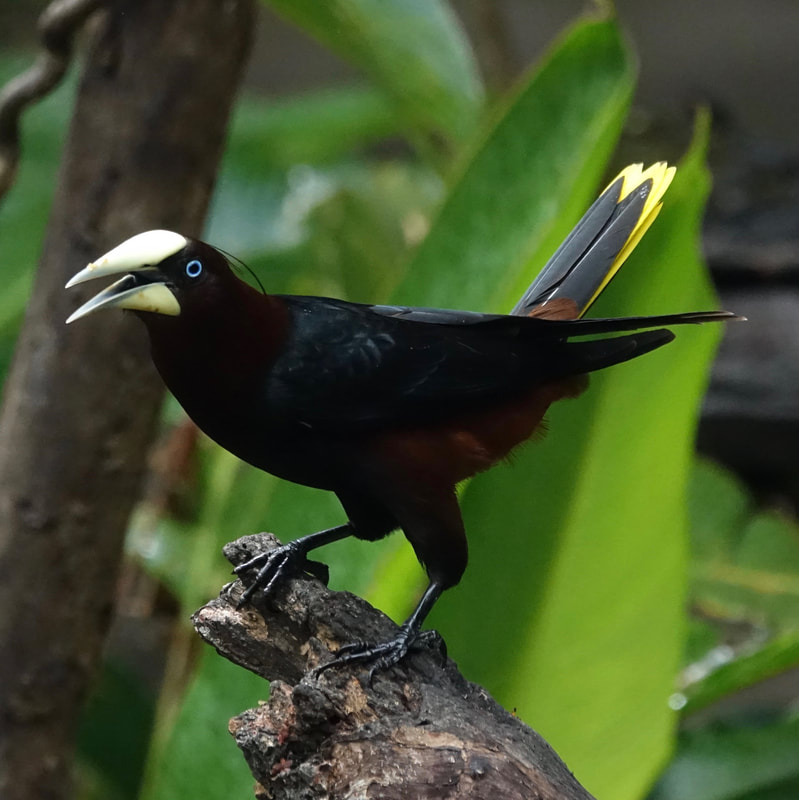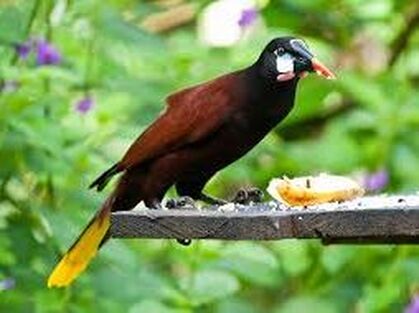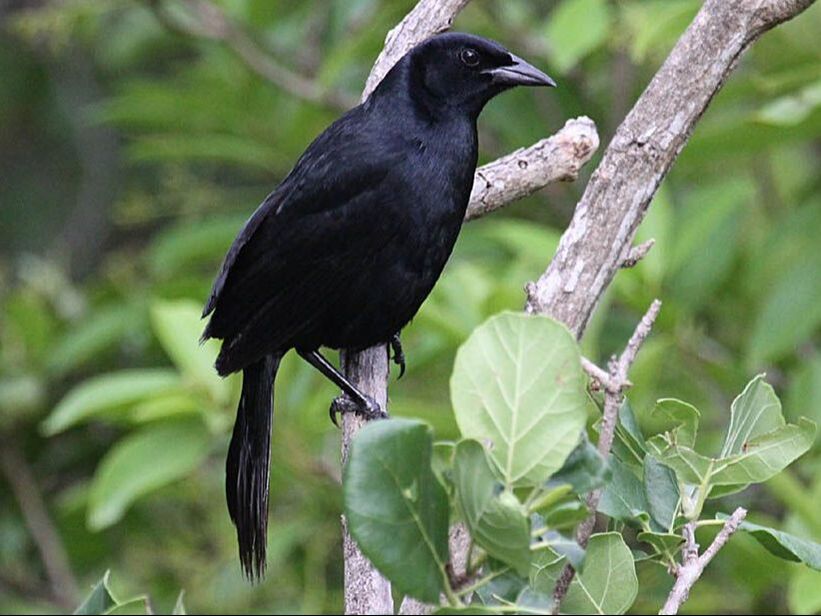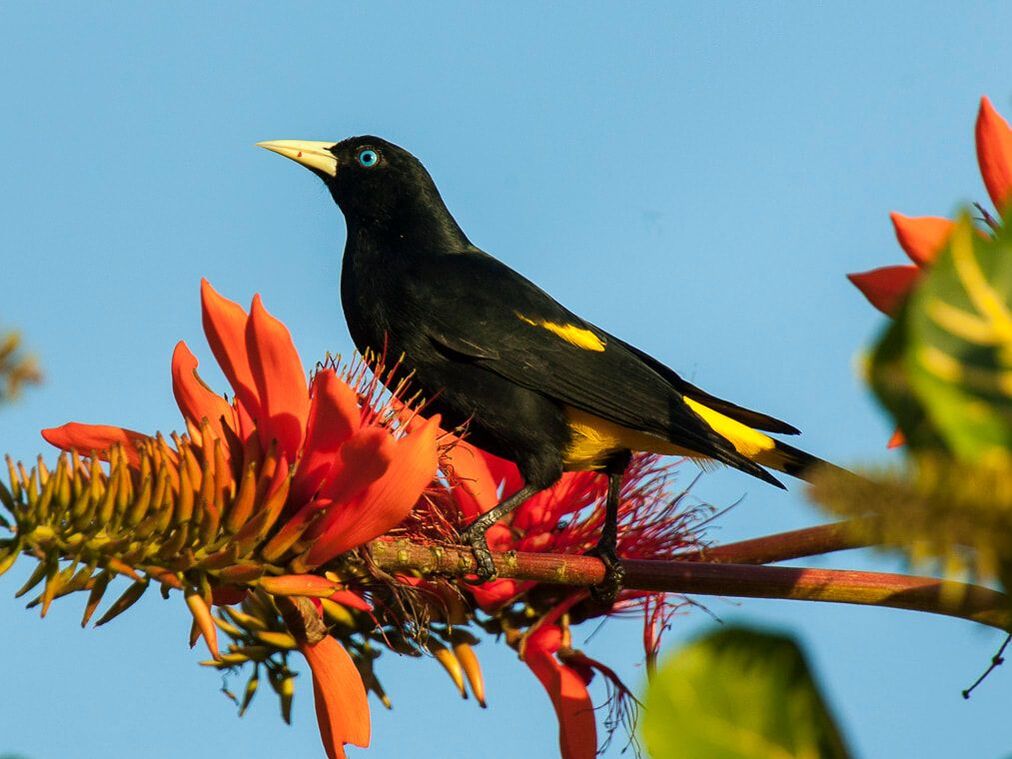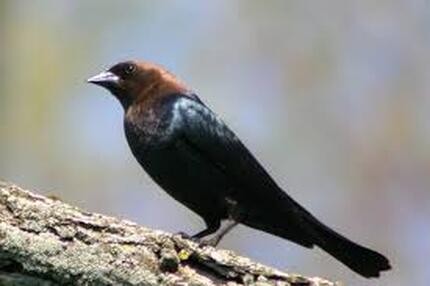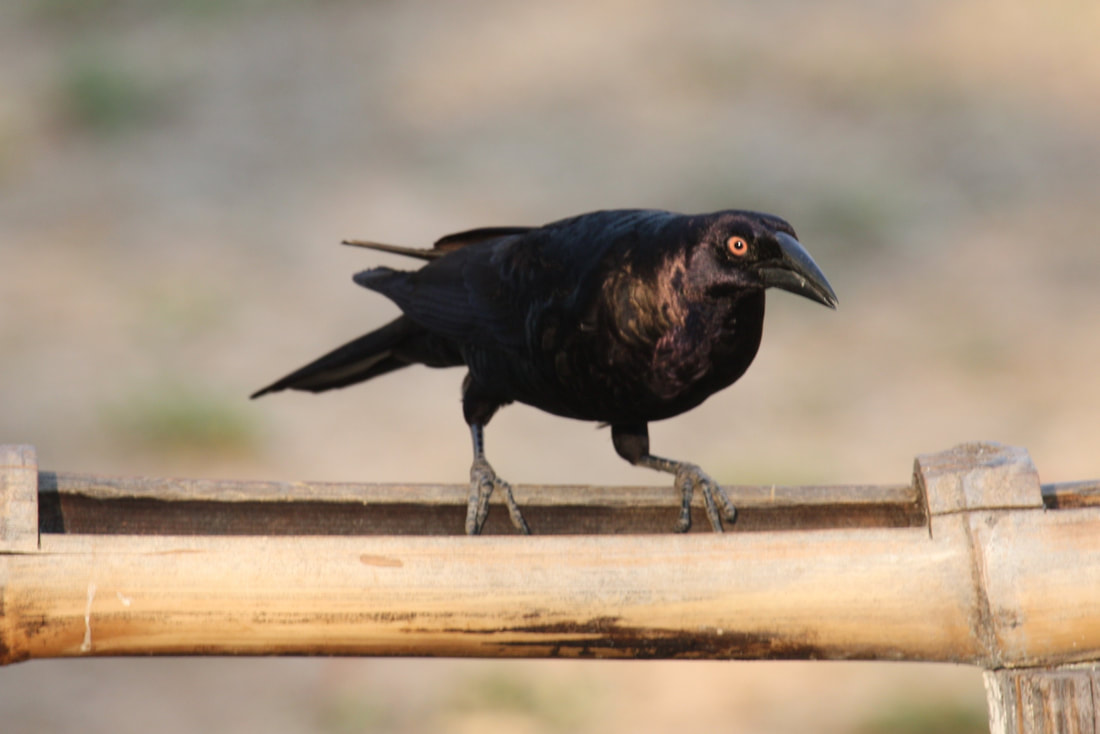Blackbirds & Cowbirds - in Belize
Bobolink
Bobolink - Breeding male is distinctive with black body, white rump, and creamy nape. Females and nonbreeders are drastically different, yellow-brown with fine streaking on breast sides, and stripes on head. Smaller than Red-winged Blackbird with shorter bill. Spiky tail feathers. In the blackbird family, although often mistaken as a sparrow. Breeds in open fields. Listen for male's bubbly song. Often in flocks during fall migration; departs early for wintering grounds in South America.
BELIZE HABITAT - Fallow fields, weedy areas. Where can I find this bird in Belize? Uncommon spring and autumn transient on cayes, regular on mainland; early April to early June and early September to late October. Interesting Facts
|
Red-Winged Blackbird
Red Winged Blackbird - Males are black with red shoulder patch that is sometimes concealed. Males have rusty feather edges in the winter. Females are streaked brown and often confused with sparrows. Look for long, sharply pointed bill. Often in flocks, especially in winter. Visits feeders. Breeds in marshes and scrubby, wet fields. Distinctive song, especially as migrants arrive in early spring.
BELIZE HABITAT - For nesting, freshwater marshes; for foraging, fallow fields, recently plowed agricultural land, pastures. Where can I find this bird in Belize? Common resident on mainland south and west to central Orange Walk, northeast Cayo, and south Belize, occasionally or locally to central Cayo and northeast Stann Creek. Interesting Facts
|
Eastern Meadowlark
Eastern Meadowlark - Streaked brown above with distinctive black "V" on breast and yellow below. In flight, short wings and spiky tail with white outer edges apparent. Bill is as long as the head and pointy. Beautiful song rings throughout grasslands in summer. Duller plumage in winter, blending into grasses even more. Similar to Western Meadowlark. Where ranges overlap in summer, listen for different song and look for mostly white malar (less yellow on throat) on Eastern. In winter, Eastern is more likely to be alone, rather than in a flock, and favors more extensive, pristine grasslands than Western. Eastern also has bolder, more contrasting head pattern.
BELIZE HABITAT - Savannas, farmland, mowed fields. Where can I find this bird in Belize? Common resident in lowlands on mainland from north Orange Walk and north Belize west to central Orange Walk and north Cayo and south through east Stann Creek to northeast Toledo. Apparently unrecorded from Corozal. Interesting Facts
|
Chestnut-Headed Oropendola
Chestunut Headed Oropendola - Rather large, dark, yellow-tailed bird of humid evergreen forest and edge in tropical lowlands. Where present, colonies of large pendulous nests adorn tall trees. Often in flocks, usually in forest canopy at fruiting trees. Male is much larger than female, but sexes look similar, with a dark, rich brown head and body, blackish upperparts, pale yellowish bill, and bold yellow tail sides. Flight much quicker than larger Montezuma Oropendola, with deep, rather swooping wingbeats that produce a rushing sound.
BELIZE HABITAT - For nesting, canopy of large trees in broadleaf forest clearings and open areas near forest. At other times, canopy of broadleaf forest interior. Where can I find this bird in Belize? Local and generally uncommon resident in south and west Toledo, west Stann Creek and south Cayo. |
Montezuma Oropendola
Montezuma Oropendola - Spectacular, very large ‘blackbird’ of tropical lowlands. Favors forest edge, open woodland, plantations, semi-open areas with trees; colonies of large pendulous nests adorn tall trees. Male is much larger than female, but sexes look similar: dark rusty overall with a black head, bold yellow sides to the tail, and ornate face and bill patterning. Flies rather directly, with slow, ‘rowing’ wingbeats. Memorable gurgling song sounds like water poured from a bottle.
BELIZE HABITAT - For nesting, canopy of isolated trees (typically the cotton tree, Ceiba pentandra). Otherwise, canoy and sub-canopy of most broadleaf forest interior and edge, relatively open areas with scattered large trees. Frequents fruiting trees. Where can I find this bird in Belize? Common resident on mainland nearly throughout, but local and somewhat seasonal in northeast. Has nested on Ambergris Caye. |
Great-Tailed Grackle
Great Tailed Grackle - Large, lanky blackbird with flat crown and long tail. Males have ridiculously long tails, almost as long as their body, often held in a V-shape. Males are glossy black. Females are brown with paler eyebrow and throat. Eyes yellow to white; dusky for immatures. In coastal Texas, where its range overlaps with Boat-tailed Grackle, note habitat (more generalized as opposed to strictly saltmarsh) and pale eye (not brown).
BELIZE HABITAT - Nearly all open areas, including rice fields, pastureland, and plowed fields; less common in wooded habitats such as open pine forest and mangroves. Where can I find this bird in Belize? Very common resident throughout, including all inhabited and many uninhabited cayes. Colonized both Belmopan Cayo and Gallon Jug Orange Walk shortly after they were established deep within continuous rainforest, and colonized remote cayes following the arrival of humans. Interesting Facts
|
Melodious Blackbird
Melodious Blackbird - Fairly common in semi-open habitats of tropical lowlands, usually in pairs or small groups. Feeds on the ground and in trees, often flipping its tail sharply upwards; may associate loosely with grackles, but usually not mixed in with other blackbids. Distinctive but lacks obvious field marks: plumage is wholly black with a slight velvety sheen; note the sharply pointed bill, and dark eyes.
BELIZE HABITAT - Ground to canopy; most open areas with scattered trees, forest edge, clearings within forest interior. Forages occasionally in fields away from trees. Where can I find this bird in Belize? Common to very common resident on mainland; also recorded from Ambergris Caye but possibly not resident. |
Yellow-Billed Cacique
Yellow Billed Cacique - Retiring blackbird of thickets and tangles. Heard much more often than seen, as pairs keep in touch with ‘question and answer calling.’ Creeps methodically in vines and tangles, and most frequently seen as it flies low across a trail or quiet road, usually with one member of the pair following shortly after the other. Note the pale ivory-yellow bill and staring yellow eyes, often striking even with a quick flight view.
BELIZE HABITAT - Understory; broadleaf and pine forest interior and edge, second growth scrub. Where can I find this bird in Belize? Common resident on mainland and Ambergris Caye. |
Bronzed Cowbird
Bronzed Cowbird - Dark brown to matte black; males with iridescent bluish wings. Thick neck and heavy bill. Look for vampire-like staring red eye. Males have an incredible display where they puff out a mane of neck feathers and hover in a circle above the female. Found in a variety of open or semi-open areas, including pastures, forest edge, yards, and agricultural areas. Visits feeders. Often in flocks, sometimes with other blackbirds.
BELIZE HABITAT - Fallow fields, pastureland and agricultural fields, brush and second growth, open areas with scattered trees. Where can I find this bird in Belize? Common resident in Corozal, north Belize and Ambergris Caye, less common south in interior to west Toledo; more widespread in winter. Formerly only a winter visitor; first documented nesting in Belize in 1968 at Rockstone Pond (Altun Ha) Belize. Interesting Facts
|
Giant Cowbird
Giant Cowbird - Rather large blackbird of tropical lowlands; male is much larger than female. Found in forest edges, pastures, orchards, and open grassy areas along rivers; often in small groups. In breeding season, hangs around oropendola colonies, where it lays its eggs in oropendola nests and relies on them to raise its offspring. Thick neck accentuates small head with very stout, pointed bill. Flight is strong and fairly direct, with distinctive flap-flap-flap-glide progression. Eye color varies: red in Mexico and Central America, yellowish in parts of South America.
BELIZE HABITAT - Nests in oropendola colonies in open areas with isolated large trees. Forages in plowed fields and other fields with sparse or low herbaceous vegetation. Where can I find this bird in Belize? Uncommon to locally common resident on mainland north to central Orange Walk and north Belize; occasionally or locally to north Orange Walk and possibly south Corozal. |


